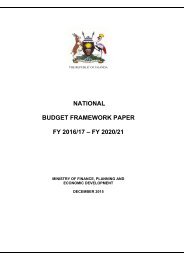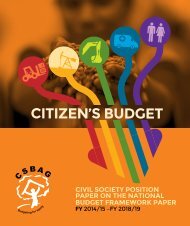CSBAG-Position-paper-on-Health-Sector-BFP-FY-2016-17-
CSBAG-Position-paper-on-Health-Sector-BFP-FY-2016-17-
CSBAG-Position-paper-on-Health-Sector-BFP-FY-2016-17-
You also want an ePaper? Increase the reach of your titles
YUMPU automatically turns print PDFs into web optimized ePapers that Google loves.
About <str<strong>on</strong>g>CSBAG</str<strong>on</strong>g><br />
<str<strong>on</strong>g>CSBAG</str<strong>on</strong>g> <str<strong>on</strong>g>Positi<strong>on</strong></str<strong>on</strong>g> <str<strong>on</strong>g>paper</str<strong>on</strong>g> <strong>on</strong> <strong>Health</strong> <strong>Sector</strong> <strong>BFP</strong> <strong>FY</strong> <strong>2016</strong>/<strong>17</strong><br />
Civil Society Budget Advocacy Group (<str<strong>on</strong>g>CSBAG</str<strong>on</strong>g>) is a coaliti<strong>on</strong> formed in 2004 to bring together civil<br />
society actors at nati<strong>on</strong>al and district Levels to influence Government decisi<strong>on</strong>s <strong>on</strong> resources<br />
mobilizati<strong>on</strong> and utilizati<strong>on</strong> for equitable, gender resp<strong>on</strong>sive and sustainable development.<br />
Since 2004, CSOs under the umbrella of <str<strong>on</strong>g>CSBAG</str<strong>on</strong>g> have engaged Government in influencing the budget<br />
process to ensure that both the local and nati<strong>on</strong>al budgets address the needs and aspirati<strong>on</strong>s of the<br />
poor and marginalized groups of people in Uganda.<br />
Introducti<strong>on</strong><br />
The health sector is critical in that it supports Human Capital Development and thus ec<strong>on</strong>omic growth<br />
and development. The sector objectives that guide resource allocati<strong>on</strong> are to reduce morbidity and<br />
mortality from the major causes of ill health and premature death and reduce disparities therein.<br />
The health sector budget in the <strong>FY</strong> <strong>2016</strong>/<strong>17</strong> is designed to help achieve the three sector outcomes of;<br />
i) Increased deliveries ii) Children under <strong>on</strong>e year old protected against life threatening diseases and<br />
iii) <strong>Health</strong> facilities receive adequate stocks of essential medicines and health supplies.<br />
Uganda’s health sector has registered improvement in key health sector indicators. For instance, under<br />
five mortality rate has fallen from 169.5 per 1,000 live births to 54.5 in the last two decades. The<br />
c<strong>on</strong>tributi<strong>on</strong> of the health services activities to the total GDP at current prices was estimated at 3.5<br />
percent in <strong>FY</strong> 2014/15 compared to 3.3 percent in 2013/14.<br />
The health sector is expected to receive 1.385 1 trilli<strong>on</strong> in <strong>FY</strong> <strong>2016</strong>/<strong>17</strong>(7% of the <strong>FY</strong> budget) from<br />
UGX 1270.8 trilli<strong>on</strong> in <strong>FY</strong> 2015/16(7% of the <strong>FY</strong> budget) reflecting an 8.99% increase in budget<br />
allocati<strong>on</strong>.<br />
The <strong>FY</strong> <strong>2016</strong>/<strong>17</strong> budget will focus <strong>on</strong> improving <strong>Health</strong> Service delivery in the following key areas:<br />
i). C<strong>on</strong>tinue with the provisi<strong>on</strong> of adequate essential drugs in all health centers;<br />
ii). <strong>Health</strong> infrastructure development with specific attenti<strong>on</strong> <strong>on</strong> c<strong>on</strong>tinued rehabilitati<strong>on</strong>, equipping<br />
and functi<strong>on</strong>alizati<strong>on</strong> of health facilities including district Hospitals and HCIIIs in all Sub counties;<br />
iii). Strengthening Human resources for <strong>Health</strong>, including community extensi<strong>on</strong> workers and<br />
development of specialized care in heart and cancer;<br />
1<br />
Exclusive of N<strong>on</strong> Tax Revenue<br />
1
iv). Strengthening the nati<strong>on</strong>al referral system, including establishment of regi<strong>on</strong>al offices and<br />
operati<strong>on</strong>al structures and a fleet of ambulance vehicles, equipment and supplies;<br />
v). Enhancing preventive health care, with particular focus <strong>on</strong> mass malaria screening, testing,<br />
treatment and larviciding as well as investing in sanitati<strong>on</strong> at household, community and instituti<strong>on</strong>al<br />
levels;<br />
vi). Address the challenge of health financing, by fast tracking establishment of the Nati<strong>on</strong>al <strong>Health</strong><br />
Insurance Scheme and provisi<strong>on</strong> of a Medical Credit Fund for private health sector players; and<br />
vii). Provisi<strong>on</strong> of family planning services to address the challenge of high fertility rates and its<br />
implicati<strong>on</strong>s <strong>on</strong> other health indicators such as infant and maternal mortality rates.<br />
<strong>Health</strong> sector Budget for <strong>FY</strong> <strong>2016</strong>/<strong>17</strong><br />
Table 1: <strong>Health</strong> sector Total budget by revenue source (Bn UGX)<br />
2015/16 MTEF<br />
Projecti<strong>on</strong>s<br />
2014/15 Outurn Approved <strong>2016</strong>/<strong>17</strong><br />
budget<br />
Recurrent Wage 273.916 330.916 330.916<br />
N<strong>on</strong>-wage 328.409 396.838 388.552<br />
Development GOU 69.695 86.214 86.714<br />
Ext. Fin 52.687 451.940 580.552<br />
GOU Total 672.020 813.969 806.182<br />
Total GOU<br />
724.707 1,265.909 1,386.735<br />
+Ext<br />
Fin(MTEF)<br />
N<strong>on</strong> Tax<br />
0.000 <strong>17</strong>.900 21.053<br />
Revenue<br />
Grand Total 724.707 1,283.808 1,407.788<br />
Source: Nati<strong>on</strong>al Budget Framework Paper <strong>FY</strong> <strong>2016</strong>/<strong>17</strong><br />
In the figure above, the wage budget remained c<strong>on</strong>stant from <strong>FY</strong> 2015/16 at UGX 330.916bn and<br />
the n<strong>on</strong>-wage budget reduced by 2.08% from UGX 396.838bn to UGX 388.552bn.The GOU<br />
financing to the sector reduced slightly from UGX 813.969bn to UGX 806.182bn by 0.95%.The<br />
overall budget to the sector (inclusive of NTR) increased by 9.66% from UGX 1,283.808 in <strong>FY</strong><br />
2015/16 to the projected budget for <strong>FY</strong> <strong>2016</strong>/<strong>17</strong> of UGX 1,407.788bn.D<strong>on</strong>or financing to the sector<br />
c<strong>on</strong>stitutes 72% of the sector’s development budget and thus places Government at the hands of<br />
d<strong>on</strong>or terms and c<strong>on</strong>diti<strong>on</strong>s as well as availability of funds to execute this <strong>FY</strong>’s budget.<br />
Past Expenditure and Medium Term Projecti<strong>on</strong>s by Vote Functi<strong>on</strong>s<br />
2014/15 Outturn 2015/16 <strong>2016</strong>/<strong>17</strong><br />
2
Vote 014:Ministry of 39.591 539.563 647.272<br />
<strong>Health</strong><br />
Vote 107 :Uganda AIDS 5.266 7.748 7.748<br />
Commissi<strong>on</strong><br />
Vote 114:Uganda Cancer 6.481 <strong>17</strong>.133 40.203<br />
Institute<br />
Vote: 115 Uganda Heart 4.909 14.491 <strong>17</strong>.265<br />
Institute<br />
Vote: 116 Nati<strong>on</strong>al 219.374 218.614 218.614<br />
Medical Stores<br />
Vote: 122 Kampala Capital 4.726 9.719 8.602<br />
City Authority<br />
Vote: 134 <strong>Health</strong> Service 3.44 4.271 4.271<br />
Commissi<strong>on</strong><br />
Vote: 151 Uganda Blood 3.234 8.703 8.703<br />
Transfusi<strong>on</strong> Service<br />
(UBTS)<br />
Vote: 161 Mulago Hospital 35.793 11.461 47.123<br />
Complex<br />
Vote: 162 Butabika 8.306 9.77 10.27<br />
Hospital<br />
Referral Hospitals 64.258 85.875 81.412<br />
Vote: 500 501-850 Local 276.643 319.155 316.303<br />
Governments-Primary<br />
<strong>Health</strong> care<br />
Total <strong>Sector</strong> Budget 672.02 1,283.81 1,407.79<br />
Source: Nati<strong>on</strong>al Budget Framework Paper <strong>FY</strong> <strong>2016</strong>/<strong>17</strong><br />
From the table above, the Ministry of <strong>Health</strong> will receive a 20% increase in health budget from UGX<br />
539.563bn to UGX 647.272bn in <strong>FY</strong> <strong>2016</strong>/<strong>17</strong>.Uganda AIDS Commissi<strong>on</strong> and <strong>Health</strong> Service<br />
Commissi<strong>on</strong> budgets remain the same in <strong>FY</strong> <strong>2016</strong>/<strong>17</strong>.Notably Uganda Cancer Institute will receive<br />
the greatest increase in the sector budget with a 135% increase in budget allocati<strong>on</strong> in <strong>FY</strong> <strong>2016</strong>/<strong>17</strong><br />
from UGX <strong>17</strong>.133bn in <strong>FY</strong> 2015/16 to UGX 40.203bn in <strong>FY</strong> <strong>2016</strong>/<strong>17</strong>.<br />
The Ministry of <strong>Health</strong> will receive the highest funding at UGX 647.272 (45.98%) and Local<br />
Governments are proposed to receive the sec<strong>on</strong>d largest share 22.26 %( UGX 316.303bn) funding in<br />
the sector.<br />
Compliance to NDP and Gender:<br />
The sector does not specifically detail its gender mainstreaming priorities for <strong>FY</strong> <strong>2016</strong>/<strong>17</strong> and<br />
performance for <strong>FY</strong> 2015/16.However in <strong>FY</strong> 2015/16, the sector immunized 102.4% of children<br />
under <strong>on</strong>e year with the 3 rd dose of Pentavalent vaccine while those immunized against measles was<br />
90% c<strong>on</strong>tributes to reduced health care by parents majority of whom are women due to their unpaid<br />
care work role.<br />
3
<strong>FY</strong> <strong>2016</strong>/<strong>17</strong> Performance Targets<br />
i. As part of its <strong>FY</strong> <strong>2016</strong>/<strong>17</strong> performance targets under Outcome 1, the sector intends to<br />
increase the proporti<strong>on</strong> of deliveries in health facilities (including health centres and hospitals,<br />
public and private Not For Profit) from 33 in 2013 to 56 in <strong>2016</strong>/<strong>17</strong>.<br />
ii. Number of family planning users attended to in all the referral hospitals 2 will increase from<br />
98,<strong>17</strong>6 users from 2015/16 to 122,615 users in <strong>FY</strong> <strong>2016</strong>/<strong>17</strong>.<br />
4.1 Alignment of <strong>BFP</strong> <strong>2016</strong>/<strong>17</strong> Financing to NDP II Public Costing<br />
Bn shs Wage N<strong>on</strong>-wage Devt Total<br />
NDP II 520 357 1,069 1,946<br />
<strong>BFP</strong> 330.916 388.552 667.266 1,407.788*<br />
<strong>2016</strong>/<strong>17</strong><br />
Source: Nati<strong>on</strong>al Budget Framework Paper <strong>FY</strong> <strong>2016</strong>/<strong>17</strong><br />
*Inclusive of N<strong>on</strong> Tax Revenue<br />
C<strong>on</strong>sidering the forecast spending for NDP II, the <strong>FY</strong> <strong>2016</strong>/<strong>17</strong> budget falls short of the NDP II<br />
public costing by UGX 401.734(26.64%).The major cause for discrepancy is financing for<br />
development that falls short by UGX 401.734bn (37.6%).<str<strong>on</strong>g>CSBAG</str<strong>on</strong>g> recommends that this funding for<br />
the sector be made commensurate to stipulated NDP II costing to achieve the medium term sector<br />
objectives.<br />
Allocati<strong>on</strong>s to Class of Output over the Medium Term<br />
2015/16 <strong>2016</strong>/<strong>17</strong><br />
Bn Uganda shillings Allocati<strong>on</strong> <strong>Sector</strong> share Allocati<strong>on</strong> <strong>Sector</strong> share<br />
C<strong>on</strong>sumpti<strong>on</strong> 662.4 68.7% 693.8 63.6%<br />
Expenditure(outputs<br />
provided)<br />
Grants and 16.9 1.8% 16.2 1.5%<br />
Subsidies(outputs<br />
funded)<br />
Investment(capital 285.4 29.6% 381.5 34.9%<br />
Purchases)<br />
Total 964.7 100.0% 1,091.5 100.0%<br />
In expenditure terms, in <strong>FY</strong> 2015/16, the sector plans to spend UGX 964.7bn in <strong>FY</strong> 2015/16 with<br />
68.7% in c<strong>on</strong>sumpti<strong>on</strong> expenditure, 1.8% (UGX 16.9bn) for grants and subsidies; and UGX 285.4bn<br />
for investment (29.6%). In <strong>2016</strong>/<strong>17</strong>, Government plans to utilize the bulk of its expenditure-UGX<br />
693.8bn for c<strong>on</strong>sumpti<strong>on</strong> expenditure, translating into 63.6% of Government expenditure; UGX<br />
16.2bn (1.5%) for grants and subsidies and UGX 381.5bn for capital purchases.<br />
2<br />
Naguru, Arua, Fort Portal,Gulu,Hoima,Jinja,Kabale,Masaka,Mbale,Lira,Mbarara,Mubende,Moroto<br />
4
<strong>Sector</strong> Issues:<br />
1 Limited staffing in the sector<br />
Low staffing remains a challenge in the sector. The current staffing needs in the sector amount to<br />
60,384 pers<strong>on</strong>ell for MoH headquarters, Nati<strong>on</strong>al Referral Hospitals, 3 central specialized instituti<strong>on</strong>s,<br />
14 Regi<strong>on</strong>al Referral Hospitals (RRH), 47 General Hospitals (GH), 166 HC IVs, 962 HC IIIs and<br />
1,321 HC IIs according to the Annual <strong>Health</strong> <strong>Sector</strong> Budget Performance Report <strong>FY</strong> 2014/15. The<br />
current staffing in the sector is 42,530 amounting to <strong>17</strong>,854 staffing gap. In <strong>FY</strong> 2015/16, Government<br />
planned for recruitment of 800 health workers in Central Government <strong>Health</strong> Instituti<strong>on</strong>s to cope<br />
with the rising populati<strong>on</strong>, of which 55 health workers had been recruited by September 2015. In <strong>FY</strong><br />
<strong>2016</strong>/<strong>17</strong>, Government also plans to undertake recruitment of 850 health workers for Government<br />
health instituti<strong>on</strong>s that would <strong>on</strong>ly reduce the staffing gap to 16,734.<br />
Recommendati<strong>on</strong><br />
CSOS urge Government to prioritize recruitment of more staff in the health sector particularly<br />
qualified health workers to enhance sectoral performance.<br />
2 Delays in Instituti<strong>on</strong>alizing the Nati<strong>on</strong>al <strong>Health</strong> Insurance Scheme<br />
A Nati<strong>on</strong>al Insurance Scheme is necessary for providing much needed affordable access to health care<br />
particularly by poor pers<strong>on</strong>s in Uganda; diversificati<strong>on</strong> of health care financing and bridging the<br />
financing gap for health care in the sector. Despite Government plans to institute a compulsory public<br />
Social <strong>Health</strong> Insurance (SHI) scheme ,the Nati<strong>on</strong>al <strong>Health</strong> Insurance Bill 2007,still awaits issuance of<br />
a certificate of financial implicati<strong>on</strong> by the Ministry of Finance as of 2015.<br />
Recommendati<strong>on</strong><br />
Urge Government to fast track the instituti<strong>on</strong>alizing of the Nati<strong>on</strong>al Insurance Scheme to provide<br />
affordable health care to all Ugandans.<br />
3 Failure to prioritize Hospital Rehabilitati<strong>on</strong> and Machinery Repair<br />
Rehabilitati<strong>on</strong> and maintenance of equipment is critical in ensuring sustainability of machinery to<br />
prevent unnecessary stalling of provisi<strong>on</strong> of health care to citizens. In <strong>FY</strong> <strong>2016</strong>/<strong>17</strong>, UGX 33.18 bn is<br />
required as additi<strong>on</strong>al funding for counterpart funding and VAT obligati<strong>on</strong>s for Government arising<br />
out of MOU agreements between Government and development partners. These include:<br />
<br />
<br />
<br />
UGX 2.6bn for VAT incurred <strong>on</strong> rehabilitati<strong>on</strong> of hospitals and supply of medical equipment in<br />
the Western regi<strong>on</strong> of Uganda<br />
UGX 15.9bn arising out of the change in VAT policy and Ushs 4.8 bn counterpart funding<br />
obligati<strong>on</strong>s for Support to Mulago rehabilitati<strong>on</strong> (kawempe, kirudu) which is scheduled to end in<br />
December <strong>2016</strong>.<br />
Ushs 9.88bn is for Counterpart funding <strong>on</strong> civil works during c<strong>on</strong>structi<strong>on</strong> of Maternal and<br />
Ne<strong>on</strong>atal health care unit at Mulago.<br />
In additi<strong>on</strong>, delays in the recruitment process of the necessary staff by the <strong>Health</strong> Service Commissi<strong>on</strong><br />
has resulted in failure to fully operati<strong>on</strong>alize and maintain the specialized equipment.<br />
5
Recommendati<strong>on</strong><br />
<br />
<br />
Government should impose a VAT exempti<strong>on</strong> in <strong>on</strong> hospital rehabilitati<strong>on</strong> and equipment<br />
maintenance in the new Government policy <strong>on</strong> payment of VAT <strong>on</strong> Government projects<br />
We recommend that Government prioritizes allocati<strong>on</strong> to footing counterpart funding in<br />
accordance with MOU agreements signed with development partners.<br />
4 Limited Transfers to Local Governments for Provisi<strong>on</strong> of Primary <strong>Health</strong> Care Services<br />
Only Ushs 44.99bn has been allocated as recurrent budget to run <strong>Health</strong> service delivery through<br />
provisi<strong>on</strong> of Primary <strong>Health</strong> care services in 137 LGs with 56 General Hospitals, 61 PNFP Hospitals<br />
and 4,205 Lower Level <strong>Health</strong> Units. Despite rising inflati<strong>on</strong> resulting in increased cost of utilities;<br />
PHC funding has not been matched by commensurate increases in the budgets of the health<br />
instituti<strong>on</strong>s. This is further compounded by the fact that a number of health facilities have a budget<br />
of less than Ushs 90,000 per m<strong>on</strong>th (excluding medicines) to deliver all the required services including<br />
utility payment, community outreaches, and health centre maintenance and support staff salaries. A<br />
short study undertaken by the Ministry indicates that to enhance health service delivery in the Local<br />
Governments, an additi<strong>on</strong>al Ushs 39.5 bn is required to make the current facilities to operate at a<br />
reas<strong>on</strong>able level. While Government provided an additi<strong>on</strong>al Ushs 4.7bn in <strong>FY</strong> 2015/16, LGs need<br />
another Ushs 35bn to be provided.<br />
Recommendati<strong>on</strong>s<br />
<br />
CSOs urge Government to allocate UGX 35bn to Local Governments to cater for provisi<strong>on</strong> of<br />
adequate Primary <strong>Health</strong> Care Services<br />
6 Limited financing to curb HIV/AIDS prevalence<br />
The World bank estimates the HIV/AIDS prevalence rate for people aged 15–49 years in Uganda as<br />
slowly rising from 6.5% in 2009 to 7.3% in 2014.Despite the growing HIV/AIDS prevalence ,the<br />
sector in <strong>FY</strong> <strong>2016</strong>/<strong>17</strong> has grossly under prioritized financing for HIV/AIDS alleviati<strong>on</strong>. It has a<br />
funding gap of 350 m for research <strong>on</strong> HIV Therapy resistance, UGX 600 m for the Populati<strong>on</strong> HIV<br />
Impact assessment Survey and a funding gap for Anti- Retroviral (ARVs) amounting to UGX 151bn<br />
to roll out 2013 treatment guidelines that shifted the treatment starting point from 350 to 500 CD4<br />
cells starting point from 350 to 500 CD4 cells.<br />
Under Ministry of <strong>Health</strong>, in <strong>FY</strong> <strong>2016</strong>/<strong>17</strong> plans to institute an AIDS Trust Fund based <strong>on</strong> the<br />
Regulati<strong>on</strong>s as passed by Parliament are underway.<br />
Recommendati<strong>on</strong>s<br />
Government should allocate more funding for curbing the HIV prevalence rate in the country.<br />
Government should fast track efforts to operati<strong>on</strong>alize the AIDS Trust Fund by <strong>FY</strong> <strong>2016</strong>/<strong>17</strong><br />
whose regulati<strong>on</strong>s were being discussed by MoH as of September 2015.<br />
PRODUCED BY:<br />
6
Civil Society Budget Advocacy Group (<str<strong>on</strong>g>CSBAG</str<strong>on</strong>g>), P.O. Box 660, Ntinda<br />
Plot 11 Vubya Close, Ntinda Nakawa Rd<br />
Fixed Line: +256-55-202-154<br />
E-mail: csbag@csbag.org<br />
Web: www.csbag.org<br />
@<str<strong>on</strong>g>CSBAG</str<strong>on</strong>g>UGANDA <str<strong>on</strong>g>CSBAG</str<strong>on</strong>g>/Facebook.com<br />
7








